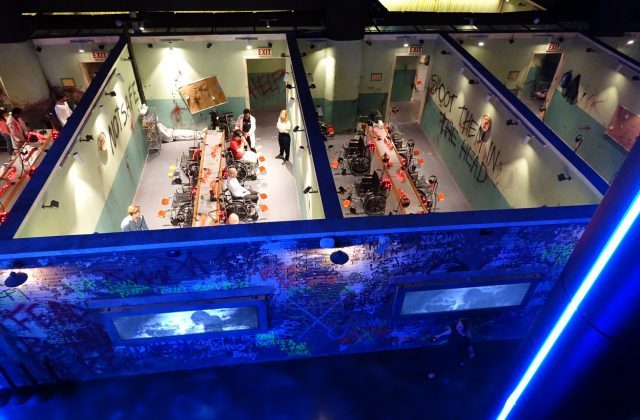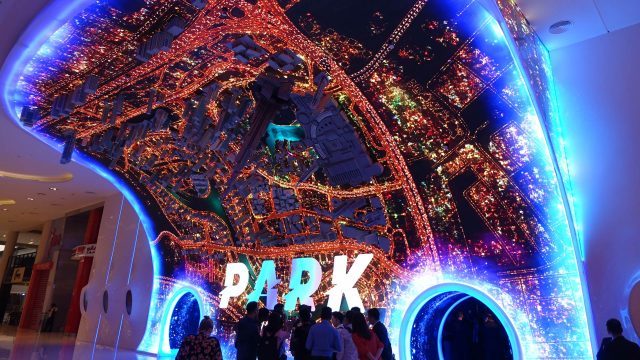The Dubai Mall, one of the world’s largest shopping complexes, is now home to VR Park, an indoor theme park spanning two floors and over 75,000 square feet of space, offering a wide variety of VR experiences, including several physical rides. At the opening of the park we went hands-on with the main attractions, many of which utilise the high-resolution, high-FOV StarVR headset.
The entrance to the VR Park makes a stunning first impression, with a huge, inverted model of central Dubai, skyscrapers extending out of a curved screen, complete with animated traffic, and the giant ‘PVRK’ logo. The flipping letter ‘A’ is perhaps also a slight nod to the small amount of Augmented Reality on show, but clearly the focus here is full-fat VR entertainment.
Once inside, you’re able to stock up on credits to pay for rides and games individually, but at 45 AED (about $12) each for the main attractions, this is an expensive way to spend a few minutes in VR. The more cost-effective approach is to select the Gold Package for 200 AED (about $54), which gives you access to seven experiences. While there are currently 18 attractions, I’d imagine working through seven of the big-hitters might be enough VR for one day for many people, if you factor in breaks and the potential queues during busy periods. During a press event, we were whisked around the attractions at a rapid pace; I would’ve certainly preferred to take a breather after each one had I been a paying customer.
Starbreeze Content Takes Centre Stage


As the senior partner, at least three of Starbreeze’s eight projects are in view from the entrance: The Raft, a new four-player co-op shooter set in a swamp, Geminose: The VR Carousel, a colourful ride aimed at a younger audience, and Overkill’s The Walking Dead VR Outbreak, the wheelchair-based zombie shooter that was used to introduce the StarVR headset prototype at E3 2015. While some of Starbreeze’s experiences have been seen at other venues (John Wick Chronicles and The Mummy Prodigium Strike are currently running in IMAX VR and SEGA Japan centres), the VR Park’s heavily-themed areas look and feel like permanent installations rather than glorified demo booths.


Some areas were more enticing than others, but if you’re looking for one example of the ‘VR theme park’ concept done right, it’s the set decoration for The Walking Dead; easily the most striking to my eyes, with creepy rooms and corridors filled with franchise references, and the park staff also dressed the part. It felt like the most complete and elaborate installation; something that wouldn’t look out of place in any of the world’s best theme parks.
VR Park Dubai is home to what is surely the largest collection of StarVR headsets in a single venue, as the high-resolution, high-FOV headset is used on five of Starbreeze’s experiences. Geminose is the odd one out, as it uses Samsung’s Gear VR; Payday: The VR Heist and The Raft currently use Vive hardware, although there are plans to move the latter to StarVR as well; the rooms where The Raft is played are already fitted with both StarVR and Vive tracking systems.
Tracked Props Make the Difference
Starbreeze’s titles offer the most immersive experiences right now, which is probably as much to do with the unique controllers (and in some cases dedicated environment designs) as it is the quality of the StarVR headset itself. Unlike the standard motion controllers used in the Vive-based games, each Starbreeze game uses accurately tracked, correctly sized props. For example, The Walking Dead uses a shotgun complete with pump action for reloading, and while John Wick uses the same content as the consumer game, the experience is enhanced by the combination of the wide FOV headset and holding a weighty submachine gun peripheral. The Mummy’s larger rifle model wasn’t quite as convincing as it felt too light, but the immersion was dramatically enhanced by the vibrating seat used to simulate sitting on the side of a helicopter, shooting enemies from the air.
Ape-X is making its first appearance at VR Park Dubai, and I found it to be the most engaging use of the StarVR headset, again combined with unique, physical props. Wearing large, metal ‘sleeves’ complete with triggers, players assume the role of Big Mike, a giant, weaponised robot ape, standing atop a skyscraper surrounded by a somewhat-recognisable future city. The game’s skyline has been customised for Dubai, with the Burj Khalifa clearly in view; when Ape-X arrives in US venues, it will feature a New York skyline.
Players stand on a slightly raised platform with a central metal column, which is soon surrounded by waves of flying enemies, some of which can be grabbed and satisfyingly hurled at others. The sturdy column can be used as cover, and your heavy arms can be held up as shields to deflect incoming projectiles. The physical platform is less than an inch above the park floor, but as it is exactly the same size and shape as the rendered ‘ledge’ in VR, there is a powerful feeling that you don’t want to ‘fall off’ the building as the action unfolds.

